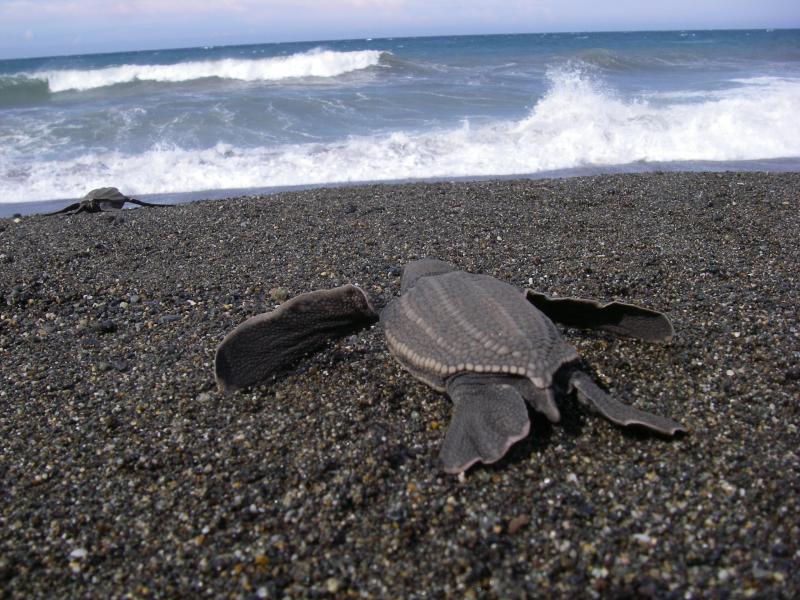
Newly mapped sea turtle genomes reveal ancient roadmap of survival
by NOAA Fisheries 12 Feb 2023 14:13 UTC

Leatherback turtle hatchling heading to the open ocean off Papua New Guinea © Scott Benson
Using genetic samples from NOAA Fisheries' tissue library, scientists have for the first time sequenced the complete genomes of endangered leatherback and green sea turtles.
Their lineages have inhabited the planet for more than 100 million years. The genetic maps published in the Proceedings of the National Academy of Sciences reveal strengths and weaknesses in the species that could help understand their risk from climate change.
"This gives us a roadmap to look at which genes are present and important for adaptation to changing environments," said Peter Dutton, program lead for the Marine Turtle Genetics Program at NOAA Fisheries' Southwest Science Center and co-author on the paper.
Comparing the genetic sequences from different species can help assess adaptive potential and whether leatherbacks may be less resilient to climate change than green turtles. The findings suggest that differences between the species may reflect underlying adaptations that help them navigate, determine their diet, and ultimately their ability to survive and adapt to changing environmental conditions.
"This will open doors to future studies across a wide range of species," Dutton said. He added that "Understanding the evolution of these species coincides with the evolution of our knowledge surrounding genetics."
Turtles survived ancient changes
He noted that sea turtles have weathered changes in climate as well as continental shifts during their time on Earth. "They are survivors, and the genome is the blueprint for understanding that," Dutton said. "What did they do and how did they change in a way that they are still here with us today? This helps us begin to answer those questions."
An international team of scientists led by University of Massachusetts Amherst postdoctoral researcher Blair Bentley completed the two sea turtle genomes. They used tissues from the NOAA Fisheries Marine Mammal and Sea Turtle Research Tissue Collection at the Southwest Fisheries Science Center. The collection holds almost 160,000 sea turtle tissue and DNA samples in walk-in freezers as cold as 80 degrees below zero. It is one of the largest of its kind in the world.
Senior author Lisa Komoroske is a professor of environmental conservation with the University of Massachusetts Amherst. She was formerly a postdoctoral scholar with NOAA Fisheries Southwest Fisheries Science Center, where she conducted some of the first sea turtle genomic studies. This new team builds on that work by generating complete genome sequences for sea turtles that scientists around the world can use to advance sea turtle biology and conservation research.
Differences between species
The differences between species can be most telling, Komoroske said. When scientists first compared the genomes of green and leatherback sea turtles, they found that they diverged from a common ancestor about 60 million years ago. However, their genomes are remarkably similar. That made the few differences stand out.
For example, green sea turtles have more genes dedicated to immunity and have evolved a better sense of smell. These traits may be part of the reason that green turtles are able to survive and adapt to changing environmental conditions. Many sea turtle populations have declined amid human activities including habitat loss, poaching, bycatch in fisheries, entanglement and ingestion of marine debris, and climate change. Yet green sea turtle populations remain significantly larger than the leatherback sea turtles.
Sea turtle conservation
Leatherback and green sea turtles are protected under the Endangered Species Act. The Pacific leatherback sea turtle is one of nine NOAA Fisheries Species in the Spotlight and a priority for recovery. NOAA Fisheries joined the U.S. Fish and Wildlife Service to develop a 2021-2025 Priority Action Plan for the Pacific Leatherback. It details the key conservation efforts needed to recover this critically endangered species. The plan includes continued genetic sampling and studies to support recovery.
The range of the leatherback sea turtle spans the entire Pacific Ocean. A turtle may lay her eggs on a beach in Indonesia and then be sighted off the coast of Central California 9 months later. Female leatherback sea turtles breed every 3 to 4 years, laying more than 2,000 eggs throughout her lifetime. It's up to all of us to ensure the conservation, recovery, and survival of these ancient sea turtle species.